
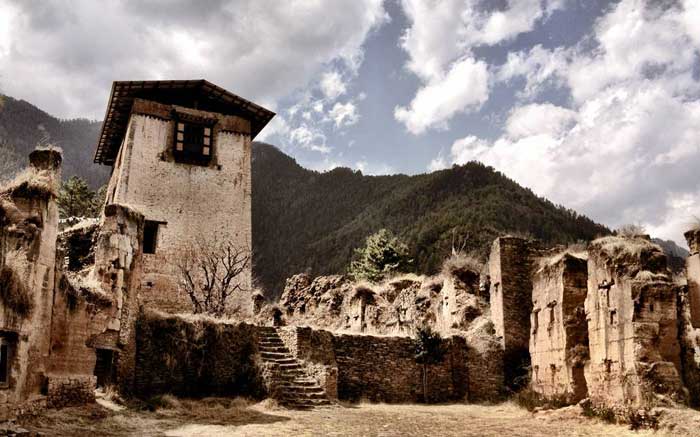
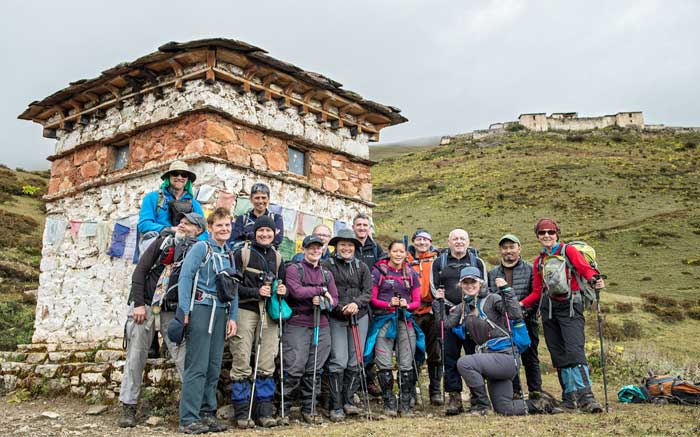
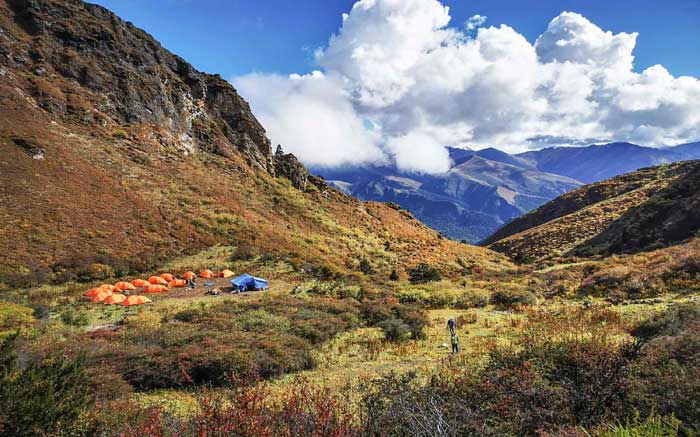
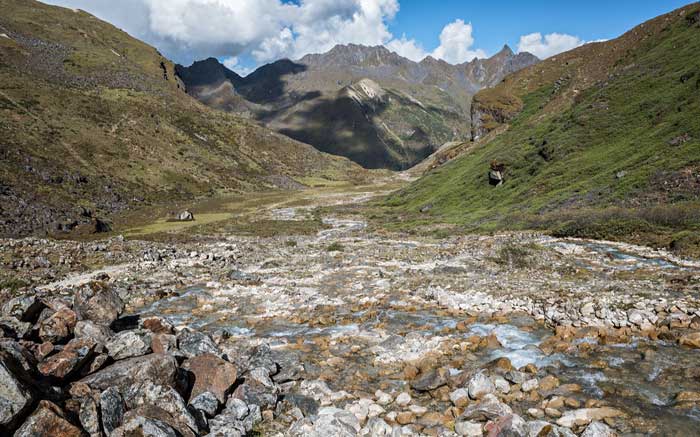
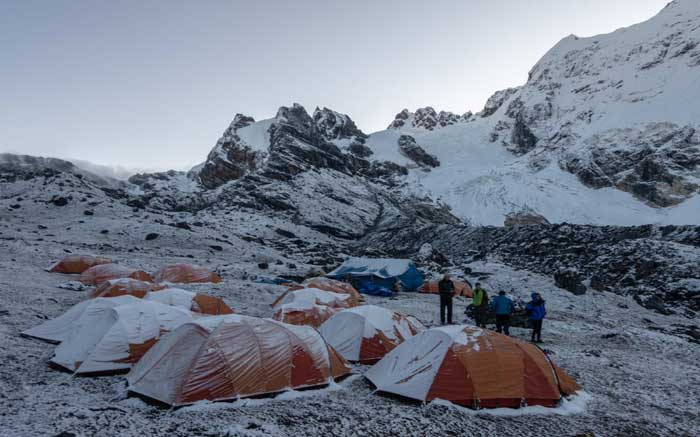
snowman trek
-
-

-
Duration
30 days
-
-
-

-
Group
16 Pax
-
-
-

-
Difficulty
Very Strenous
-
-
-

-
Accommodation
Hotel / Lodge
-
-
-

-
Season
All Season
-
This spectacular 30-day adventure in Bhutan begins with the 25-day Snowman trek into one of the country’s most remote valleys. This is probably one of the hardest high altitude treks, but an incredible experience for anyone who takes the challenge. Bhutan’s pristine landscape, wonderful people and fascinating Buddhist culture provide the ingredients for a memorable journey into one of the world’s most remote kingdoms.
Travelling into the Lunana district the Snowman trek is so named for the six mountains over 7000 metres (23,100 ft. ) which the trek passes beneath. Crossing nine passes over 4500m (15,850 ft. ) makes this not only one of the highest altitute treks, but also one of the most challenging. Starting in Drukgyel Dzong after a short drive from Paro, we will set out heading directly towards Jhomolhari at 7314m (24,135 ft.) the third highest peak in Bhutan.
Following the Paro Chhu river valley up into the mountains will be a prelude to the magnificent high altitude trekking which follows. Passing Buddhist monasteries and small villages we will witness a land unchanged for hundreds of years. By placing a strong emphasis on preserving its natural and cultural history, Bhutan has an aura of authenticity which engages your heart and mind while trekking. Glide past blue pine, juniper and rhododendron forests, and look for the famous Himalayan blue sheep, bearded vultures and Himalayan griffons flying overhead.
After a strenuous but tremendously rewarding 25 days of trekking we will turn our attention to learning more about Bhutan’s cultural heritage and Buddhist traditions as we return by road across the middle of Bhutan, known as the Inner Himalaya, visiting Punakha, and Thimphu, before returning to Paro for our final night.
Itinerary
-
Day 1
Arrival Paro
You local escort will receive you at the Paro airport and take you to the hotel. After freshening up, you will be taken for a tour of Paro town including the ruins of Drukgyel Dzong and Kycihu Lhakang.
-
Day 2
Tiger Nest hike
You will be taken for a hike to Taktshang or Tiger’s nest, an uphill walk of about three hours. This hike is basically done to accustom trekkers to the mountain altitude of the Himalayas. The Tiger Nest, precariously perched on a cliff, offers a spectacular view of the Paro valley. You will also get to visit the inner sanctum of one of the most religious sites in the country.
-
Day 3
Drukgyel Dzong – Shana (17km, 5-6 hours)
The trek begins from the Drukgyel Dzong (2,580m) road point. Initially, the trail is a gentle climb along the banks of Parochhu adjacent to vast swathes of paddy fields. The trail passes through green meadows, apple orchards and traditional Bhutanese farmhouses. After about four hours of trekking, you will reach the army outpost at Gunitsawa village. From there, you will have to walk to the other side of the river across the Shana Zampa to the campsite.
-
Day 4
Shana – Soi Thangthangkha (20km, 7-8 hours)
This is a long trek that involves walking uphill and downhill at short intervals. After climbing uphill through the river valley, you will enter the Jigme Dorji Wangchuck National Park. The valley narrows down to a single path that descends to a meadow. The camp will be set up here. This is a right spot for the camp as you will be able to see Mount Jomolhari on a clear day.
-
Day 5
Soi Thangthangkha – Jangothang (19km, 7-8 hours)
You resume the trek early in the morning. The trail continues uphill across alpine meadows and stunted vegetation. Along the trail, you will be able to view Mount Jomolhari. You will come across an army outpost on the way, yak herders’ homes, and the beautiful snow clad mountain peaks and ridges on the horizon. The trail further passes through the highland villages of Soe, Takethang and Dangochang. Here you will be able to experience the typical lifestyle and culture of highlanders. You will continue till Jangothang (4,040m), the campsite at the base of the majestic Mount Jhomolhari, the abode of the protective deity Jomo.
-
Day 6
Rest day at Jangothang
A day will be spent at Jangothang. Short hikes offer the opportunity to see lakes and various other mountain peaks like Mount Jomolhari and Mount Jyichu Drakey. There are also possibilities of sighting blue sheep grazing on rocky mountain slopes. There are good short hiking trails in three directions – Jomolhari and it’s subsidiary mountain chains lie directly west, Jyichu Drakey to the north and a number of unclimbed peaks to the east.
-
Day 7
Jangothang – Lingshi (18km, 7-8 hours)
After the day’s halt, you will resume the trek. The trail from the camp ascends through a steep ridge for about half an hour. After that it is a gradual downhill walk to the Nyilila pass at 4,870m. From here, you will be able to view Mount Jomolhari, Mount Jyichu Drakey and Tsherimgang, all above 7,000m. Along the trail, you may also sight herds of blue sheep grazing on the slopes. The downhill trek will take you to Lingshi, a highland settlement at 4,000m. Along this trail you will also come across yak, yak herders and their homes. You will see Lingshi Dzong on a clear day. You will halt at the campsite before you reach Lingshi dzong.
-
Day 8
Lingshi – Chebisa (10km, 5-6 hours)
It is going to be an easy day of walking. So relax. Shortly after reaching the Chorten below Lingshi Dzong, you have the choice of staying on the main trail or taking the diversion that leads to the Lingshi Dzong (4,220m), which sits right atop a ridge. Lingshi Dzong offers a serene view of the valley. As you conitue the trek, you will pass through the villages of Lingshi and Goyul. The campsite at Chebisa at the backdrop of the village and beautiful waterfall, you can get time to visit the village and interact with the communities.
-
Day 9
Chebisa – Shomuthang (17km, 6-7 hours)
The trail goes through a wide pastureland towards Gobu La pass at 4,410m. After crossing the pass, you will descend to the valley. From there you will climb a little after which the trail descends to Shakshepasa (3,980m) where a helipad has been built. You will again climb till the campsite at Shomuthang located above a river, a tributary of the Nochu river.
-
Day 10
Shomuthang – Robluthang (18km, 6-7 hours)
You will start early as the going is quite tough along this trail. You will climb up the valley and almost after two hours, you will reach Jhari La at 4,750m. From here, you will be able to see Sinche La, the pass you will have to cross the day after. You will also see Mount Gangchhenta (6,840 m) also known as the Great Tiger Mountain. On a clear day, you will also be able to see Tserimgang and the peak of Mount Jumolhari. You will walk down to Tsheri Jathang. This valley is the summer habitat of Takin and rightly declared as the Takin sanctuary. From here you will climb uphill to reach the campsite at Robluthang (4,160m).
-
Day 11
Robluthang – Lemithang (19km, 6-7 hours)
After crossing Sinche La (5,005m) – the highest pass on the route – you will head towards Laya. On the way you will come across Laya women clad in their traditional attire weaving. From here you can catch the view of a glacial lake at the foot of the valley and a terminal moraine. The descent will continue, and after crossing Kango Chhu reach Lemithang campsite (4,140m). From the camp, the peak of Gangchhenta is visible.
-
Day 12
Lemithang – Laya (10km, 4-5 hours)
The trail continues to descend along a narrow river valley and leads to a dense forest. The trail continues on the west side of Laya village from where you can view Gangchhenta and Masagang. The campsite is below the school in Laya (3,840m).
-
Day 13
Rest day at Laya
You will take the day off and rest in Laya. You can engage in short hikes, visit the community school and meet local inhabitants. The interaction would enrich your understanding and knowledge of these people’s lifestyle, culture, and traditions.
-
Day 14
Laya – Rodophu (19km, 6-8 hours)
From Laya, the trail descends to an army camp and follows the river until the turn-off point to Rhoduphu. After lunch, the climb continues through rhododendron bushes till you reach the campsite at Roduphu (4,160m), next to the Rhoduchhu.
-
Day 15
Rodophu – Narethang (17km, 5-6 hours)
The trail follows the river for about half an hour after which it climbs up to an open valley at 4,600m and further up to Tsomo La at 4,900m. From here, you can have a spectacular view of Lunana, Mount Jomolhari and Jyichu Drakey, and the Tibetan border on the other side. The trail then crosses a flat, barren plateau at about 5,000m. The campsite at Narethang (4,900m) is towered by the peak of Gangla Karchung (6,395m).
-
Day 16
Narethang –Tarina (18km, 5-6 hours)
From the campsite, the trail climbs up for about an hour to Gangla Karchung La. From this pass at 5,120m, you will have a magnificent view of the Jekangphu Gang (7,100m), Tsenda Kang and Teri Gang (7,300m). The trail then descends along a large moraine, and continues downward through thick rhododendron vegetation to Tarina valley. You camp along the Tangchhu (3,970m)
-
Day 17
Tarina – Woche (17km, 6-7 hours)
The trail runs through conifer forests on the upper ridges of the Pho Chhu. Along the way, you will come across beautiful waterfalls. The trail ascends over a ridge and then descends to Woche (3,910m), the first village in the Lunana region.
-
Day 18
Woche – Lhedi (17km, 6-7 hours)
The trail continues through juniper and fir forests, and further through rhododendron bushes. The route ascends to Keche La pass at 4,650m from where you can have spectacular view of the mountain ranges. The trail then descends to the riverside and through a village from where you can see the table mountain. The trek continues up the riverside till the village Lhedi (3,700m).
-
Day 19
Lhedi – Thanza
From Lhedi, you will walk few hours to reach Thanza village where you will take the day off.
-
Day 20
Rest at Thanza
Here you will be able to walk around the village, interact with local people and experience the highland culture.
-
Day 21
Thanza – Danji (8km, 3-4 hours)
The trail climbs up to a large boulder from where you will get an excellent view of Thanza, Toencha and Choso village and the surrounding mountains. The trail is relatively easier and after a few hours of walking through almost flat area, you will reach a meadow with a few yak herders’ huts. Near the campsite at Danji (4,230m), there is a trail junction – one route leading to Gangkhar Puensum base camp and the other to Bumthang or to Sephu in Trongsa.
-
Day 22
Danji – Tshochena (12km, 5-6 hours)
This trek will follow the route to Sephu. The trail crosses through the creek and after a long climb, reaches Jaze La at 5,150m. After the pass, the trail descends to the campsite near Tshochena lake (4,970m). Along the way, you will come across several lakes.
-
Day 23
Tshochena – Jichu Dramo (14 km, 4-5 hours)
The trail goes along the banks of a green lake before arriving at a ridge (5,100m) from where you can have a spectacular view of the mountain ranges. The trail then ascends and descends over small hills and reaches a glacial lake. After that, the route descends and then again ascends to first Loju La (5,140m). Finally after crossing a small saddle (5,100m) you will enter a wide glacial valley from where the trail descends gradually to the campsite at Jichu Dramo (5,050m).
-
Day 24
Jichu Dramo – Chukarpo (18km, 5-6 hours)
The trail ascends through a moraine to the highest pass on the trek Rinchen Zoe La (5,320m). From here, you will see a panoramic view of Gangkar Puensum. The route then descends to a wide valley with several lakes and further down along a moraine to the Thamphe Chhu. From here, you will be able to see trees. After a few hours of walk, you will reach the campsite at Chukarpo (4,600m).
-
Day 25
Chukarpo – Thampe Tsho (18km, 5-6 hours)
The route descends along the river till you reach the yak herder huts at Gala Pang Chhu at 4,010m. From here the trail climbs steeply towards Thampe Tsho (4,300m)
-
Day 26
Thampe Tsho – Maurothang (14km, 5hours)
The route ascends steeply to the last pass on the trek the Thampe La at 4,600m. Along the way, you may sight herds of blue sheep. After the pass, the trail descends to the sacred lake Om Tso. After passing a waterfall you will reach another smaller lake 100m below. After that, you will descend steeply to the Nikka Chhu. The trail leads through mixed forest to large clearing on the banks of the river with a few yak herder huts at Maurothang (3,610m).
-
Day 27
Maurothang – Sephu/Wangdue (18km, 5-6 hours)
This is the last phase of the trekking. The trail follows the Nikka Chhu and finally reaches the village of Sephu and to the road point at the Nikkachhu bridge.
-
Day 28
Sephu – Thimphu
Early in the morning, you will be driven to Thimphu. On the way, you will visit the Wangduephodrang dzong.
-
Day 29
Rest day in Thimphu
You may like to take rest after the tiring trekking. However, depending on your choice, you can visit certain historical monuments in Thimphu. You may also take a tour of the city and do some shopping.
-
Day 30
Departure
What's included
Price Details
Please enquire with us for prices
Price Includes
- - All ground transportation by private vehicle for airport and hotel pick up/drop off, sightseeing and transfers
- - All domestic flights (if any)
- - Accommodation in teahouses and hotels
- - All meals during trek
- - Entry permit to parks, monuments and cultural landmarks
- - Trekking guide(s), porter(s) and driver(s) their daily wages, food, accommodation and other expenses
- - Comprehensive medical kit
- - In case of emergency, we can send helicopters for evacuation, manage all paperwork, and deal with related insurance companies (provided the client has valid insurance)
Not included
Price Excludes
- - International airfare and airport departure tax
- - Travel insurance covering medical treatment and evacuation by ground and air
- - Nepal entry visa, obtained upon arrival at the Tribhuwan International Airport in Kathmandu
- - Rescue and evacuation
- - Extra road transport/flight cost in case member returns earlier
- - Lunch and dinner in Kathmandu and if applicable, in Pokhara
- - Items of personal nature like laundry, communication and bar bill
- - Tips for trip staff and driver. (Tipping is appreciated)
- - Other expenses not mentioned in the Price Includes section
Life on Trek
Trekking staff
Whilst on the trek, the Nepali guides and porters will ensure that you are well looked after. Every trek has an English speaking guide, known as the Sirdar, who is in overall charge. It is his responsibility to organize the trek en route and manage the guides and porters and deal with the local peoples and they are experts in trek organization, as well as being able to discuss the local culture, religion, and landscape. In addition there will be other guides, sometimes referred to by the generic term Sherpa, who will be your walking companions on the trek and will assist the Sirdar in organizing the logistic of the trek. On camping treks there will be full kitchen crew who are responsible for all aspects of catering. And finally there will be porters who are the transportation system of the Nepali mountains. They will carry the duffle bags and other equipment as necessary.
Accommodation
- Fully equipped Camping treks - accommodation is provided in spacious 2 person tents. We use this method for our climbing trips and some treks where lodges are less frequent.
- Lodge trek - accommodation is provided in the local Nepali lodges, some times known as tea- houses. It is usually necessary to share a double room. We use this method for our treks in the Annapurna and Everest regions.
Food
On camping treks, all food is prepared by the trek cook - an expert in preparing delicious camp food. And most importantly, special care is taken to provide well - boiled, purified drinking water. On lodge treks, food is provided in the lodge and this ranges from delicious local specialties to common western dishes. If necessary, bottled water can be purchased from the lodges for a small fee, although many trekkers prefer to use fresh water with the added precaution of a purifying agent. You could bring some Chocolate or special energy drinks for yourself as these are hard to get in the Himalayas.
A typical trekking day
A typical day revolves around the Nepal sunrise and sunset. The day starts with an early wake up call. You then pack up your gear and enjoy a rousing breakfast before starting your morning's walk. The Sirdar will already be organized loads to porters and or animals, and your group will then set off on the trail at a leisurely pace, enjoying the view and stopping to take photographs. After 2-3 hours walk you stop for lunch. This lasts for about 90 minutes which gives you time to relax, or explore the local village. The afternoon's walk is usually shorter and we arrive at the campsite or tea-house in plenty of time to relax and savour the surroundings. Later in the evening dinner is served, giving you an opportunity to sample the delicious food, talk over the day's events, and look forward to another special day on the trails of Nepal.
Health and safety on the trek General
- A comprehensive first aid kit is carried on the trek. However we advise that you also carry your personal first aid kit which includes specific items of preference.
- We will, in an emergency, arrange for helicopter evacuation. (Note that you are required to hold insurance for this unlikely eventuality).
- All meals on our camping trips are prepared to strict hygiene standards specifically for our groups, under the supervision of the trekking staff.
- We use tea-houses that we now have strict hygiene standards and provide a broad menu.
High Altitude
Anyone can be affected by Altitude Sickness. However, our itineraries are specifically designed to minimize the risks associated with trekking to high altitudes by building in acclimatization and rest days. In the event of any symptoms we will ensure that the individual descends to a lower altitude to gain a quick recovery.
And finally……….. It must be stressed that whilst trekking in the Nepal Himalaya is challenging and rewarding, you must be prepared for he occasional inconvenience or discomfort. The correct mental attitude to trekking is as important as being physically prepared.
Equipments
All equipment and food, and your own personal backpacks are carried by the porters or pack animals. It is only necessary to carry a camera or small daypack ! On camping treks all necessary camp equipment is provided - this includes dining tent, dining table and chairs, toilet tent, foam mattresses, and all cooking equipment. The only kit that you will need to bring is your own personal equipment and clothing.
Recommended Trekking Kit
The following is a list of clothing and accessories that we recommend that you take with you. This is not intended to be a comprehensive clothing and equipment list, rather it is intended to act as a reminder of those items that we feel are essential for your comfort and convenience. However we recognize that you may have your own personal preferences for clothing which may be equally as suitable.
Footwear
- Walking boots with suitable ankle support that have been worn - in prior to the trek, and which are waterproof.
- Trainer or casual shoes, for trekking andor for traveling
- Warm socks for colder areas.
- Gaiters ,,in case of rain or snow.
Leg wear
- Loose, casual trousers for trekking.
- Thermal leggings for colder areas.
- Long skirt for women as an alternative to trousers
- Waterproof trousers
Body
- Selection of T-shirts, and long sleeved shirts, preferably not cotton.
- Thermal shirt for colder areas.
- Warm shirt, possibly fleece, for colder areas.
- Fleece jacket or warm wool jumper.
- Windproof, waterproof outer shell garment for higher altitudes.
- Down jacket (optional for cold nights & mornings: can be hired in Kathmandu cheaply)
Head Hands
- Wool or fleece hat, or balaclava.
- Hat or cap for sun protection while trekking.
- Sunglasses or goggles.
- Sunscreen lotion and lip balm
- Warm gloves.
Other Items
- Strong rucksack, or large holdall to be carried by porters
- Day sack to be carried personally.
- Plastic bags or stuff sacks to storeseparate trekking gear inside your main bag.
- One liter water bottle.
- Personal first aid kit to include essential items.
- Sleeping bag 4 season.
- Torch, ideally head torch.
- Camera and film! - for those not to be forgotten shots of the Himalaya.
- Toilet items and towel.
- Large handkerchief bandana for neck.
Recommended Mountaineering Kit
In additional to the items mentioned above for trekking the following is a list of the additional specialist items which are required for the trekking peaks.
- Plastic or Leather mountaineering boots, with gaitors & crampons that have been tested for a good fit.
- Fleece trousers or salopettes.
- Additional mitts and gloves suitable for climbing.
- Ice ace, and ski poles (Note: ice axe can hired in Kathmandu)
- Climbing harness
- 2 X tape slings
- 2 X screw gate karabiners.
- Descended abseil device Ascender
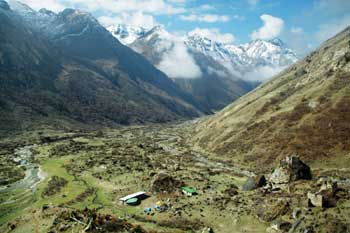
 10 days
10 days
 Moderate
Moderate

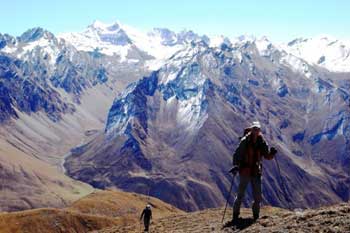
 Easy
Easy
